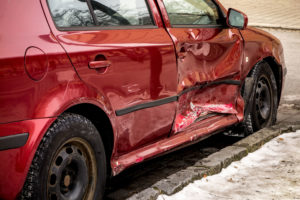What to do After Your Car is T-Boned
When your vehicle is T-Boned, it means the front-end of another car has collided with your car on the driver’s side. This type of accident is hazardous as the impact can cause your head to do a side-to-side whiplash where it hits the driver’s window glass, then whips to the other side. There is nothing except the driver’s side door between you and the other vehicle.

Some auto manufacturers have developed and installed side-impact curtains, which are airbags that inflate on impact to help avoid hitting your head on the glass. They can also help cushion the impact from the vehicle hitting your body. Additionally, they can help prevent a person from being ejected from the car.
What are the Common Causes of T-Bone Accidents?
According to research, T-bone accidents are much deadlier for smaller vehicle occupants than for occupants of larger vehicles like SUVs and vans. This is because smaller cars cannot redistribute the energy from the impact of the collision as well as larger vehicles can. The causes of T-bone collisions can include:
- Failure to yield right of way at an intersection
- Speeding
- Failure of one driver to make a safe left-turn
- Not stopping for stop signs or red lights
- Icy roads, defective brakes, or other vehicle defect
The Most Dangerous Roads in Tampa
EverQuote compiled data from the NHTSA and found that Highway 4 in Tampa is the most dangerous in the United States. The community organization Plan Hillsborough’s Vision Zero program details Tampa’s most dangerous streets. The list includes:
- Mango Road/CR579 (MLK Boulevard to US 92)
- 78th Street (Causeway Boulevard to Palm River Road)
- Gibsonton Drive (I-75 to Balm Riverview Road)
- 15th Street (Fowler Avenue to Fletcher Avenue)
- Bruce B Downs Boulevard (BBD) (Fowler Avenue to Bearss Avenue)
- Sheldon Road (Hillsborough Avenue to Waters Avenue)
- Lynn Turner Road (Gunn Highway to Ehrlich Road)
- Fletcher Avenue (Armenia Avenue to Nebraska Avenue)
What are the Most Common Injuries from T-Bone Accidents?
Many factors contribute to the type and severity of injuries sustained in T-bone accidents. Common injuries can include:
- Traumatic Brain Injury due to impact with the steering wheel, window glass, or other items in the vehicle.
- Severe trauma to the left side of the body.
- Internal injuries such as collapsed/punctured lungs or other perforated organs.
- Becoming trapped in the seat belt or ejected if not wearing a seat belt.
- Broken neck, torn muscles, herniated spinal discs, and more from the impact and whipping effect of the head and neck.
What do I do After a T-Bone Accident?
The first step is to seek immediate medical attention, even if you believe you were not injured. The shock and trauma can desensitize you to potentially significant injuries. It may take hours, days, or even weeks for the symptoms of injuries to present themselves. Delaying medical attention could not only harm your well-being, but it can also cause hardships later on in the insurance claims process.
We advise that you contact us as soon as possible. Darrigo and Diaz Law has an expert team of vehicle rollover collision attorneys that can help reconstruct the event and get you the compensation you need to cover medical expenses. We encourage you to immediately reach out to us online or by calling (813) 774-3341 for a confidential, free, and no-obligation phone consultation.
